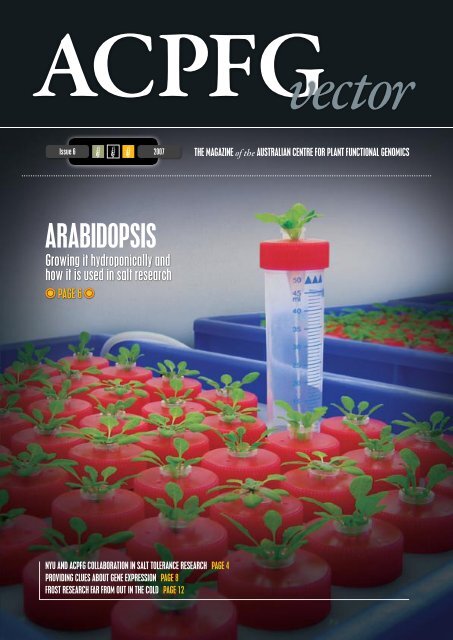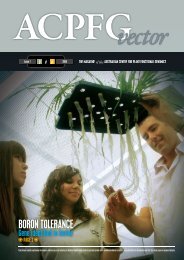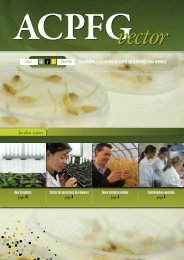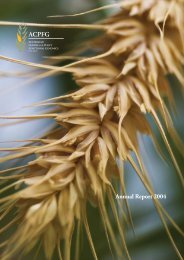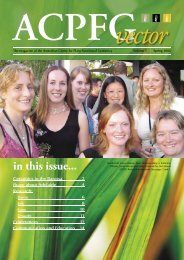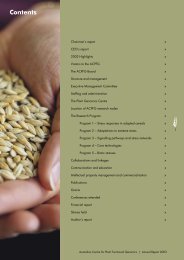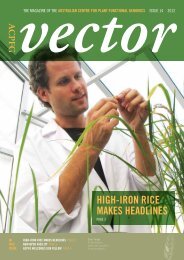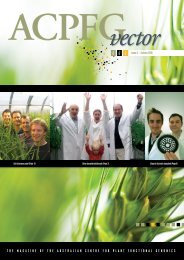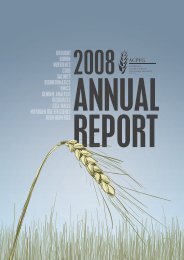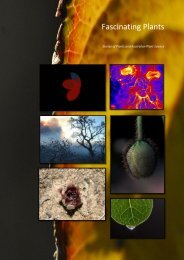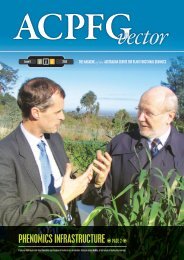Issue 6 2007 - acpfg
Issue 6 2007 - acpfg
Issue 6 2007 - acpfg
- No tags were found...
You also want an ePaper? Increase the reach of your titles
YUMPU automatically turns print PDFs into web optimized ePapers that Google loves.
ACPFG VECTORMake the leapIn this issuePage 4 Sorting out Salinity StressPage 6 Growing Arabidopsis in HydroponicsPage 7 Arabidopsis (Part 2)Page 8 Providing Clues for Gene ExpressionPage 10 Looking Out for Health and SafetyPage 12 Out in the ColdPage 13 Lab to LandPage 14 CSIRO <strong>2007</strong> Root and Soil Biology WorkshopPage 15 PhD Candidate Nominated for Best PaperPage 16 Transforming the Scientists of TomorrowPage 20 Get into Genes New DevelopmentsPage 22 New FacesIs your advertising agency treating you like a small fishin a big pond – but charging you big fish prices? Make theleap to Deep Blue Water Communication and enjoy bigagency expertise without a big agency price tag.Call us today on 08 8359 3332or visit www.dbwc.com.auGrants won!ACPFG were recently notified of the following successful grant and award applicationsDr BN Kaiser; Prof MA Tester; Dr JA Rafalski; Dr K Dhugga won anARC Linkage Grant titled ‘Targeted approaches to improve nitrogen useefficiency in maize’ valued at $900,000 over three years. Collaborating /Partner Organisation and co-applicant is DuPont Pioneer. The grant willsupport collaborative research by the University of Adelaide and DuPont-Pioneer into the efficient use of nitrogen in maize. The collaboration withPioneer was established by the Australian Centre for Plant FunctionalGenomics of which the University is the largest shareholder.Jenna Malone and Alexandra Smart were awarded a‘Commercialisation Training Scheme Scholarship’ to undertake theGraduate Certificate in Commercialisation at the University of Adelaidecommencing in semester 2, <strong>2007</strong> valued at $20,000 each. Recipientsof these scholarships must maintain full time enrolment in a higherdegree by research while undertaking the CTS.Prof MA Tester won a Crawford Fund Training Award valued at$8000 towards the training of Dr Sunita Gupta. Dr Gupta is workingwith Dr Yuri Shavrukov on salt tolerance in Triticum monococcum.Dr Jacqueline Batley from ACPFG’s Queensland node won aYoung Scientists Exchange Scheme travel grant offered through theDepartment of Education, Science and Training (DEST) and theChinese Ministry of Science and Technology (MOST). Dr Batley willtravel to China to participate in the Australia China Young ScientistsExchange Scheme. The visit will take place from 22 July to 6 August<strong>2007</strong>. This newly established scheme aims to promote collaborationbetween younger Australian and Chinese scientists by allowingparticipants to form research networks and explore possible areasof collaborative research.2
ACPFG VECTORSorting outSalinity StressDr Alexander Johnson sorting cells using the FACS machine at Flinders Medical CentreDr Alexander Johnson is a molecular biologist working in ACPFG’s Salt Focus Group. His research investigates salinity tolerancemechanisms in rice and Arabidopsis, as well as metal transport in rice. He was previously a Postdoctoral Research Associate atthe University of Cambridge (UK) with Prof Mark Tester, where he developed a library of rice enhancer trap lines. He has spentconsiderable time in Montpellier, France at the agricultural research institute CIRAD (Centre de coopération internationale enrecherche agronomique pour le développement) and continues to collaborate extensively with researchers there.4
ISSUE 6 – <strong>2007</strong>LEFT (FIGURE 1): A rice enhancer trap line with GFPfluorescence specific to the root cap;image captured by confocal laser scanningmicroscopy (Photo: Alex Johnson)BELOW: Six day-old rice seedlings that werelater used for the salinity experimentsDid you know?There are three main ways that plants tolerate salt:Preventing sodium ions from entering the rootIf sodium ions do enter the root, they are stoppedfrom moving into the shootIf sodium ions get into the shoot, they are lockedaway in storage compartments called vacuolesACPFG research is investigating the genetic controlof these three strategies.By Amanda Hudswell and Dr Alexander JohnsonThrough an ARC Discovery Grant won by Prof Mark Tester (ACPFG),Prof Roger Leigh (University of Adelaide), Dr Alexander Johnson(ACPFG) and Dr Ken Birnbaum (NYU), a new ACPFG collaborationwith New York University (NYU) is providing novel insights into howplants respond to salinity stress.In February this year, Dr Johnson visited Dr Birnbaum at NYU’sCenter for Comparative Functional Genomics to trial the use offluorescently-activated cell sorting (FACS) for isolating specific celltypes of rice and Arabidopsis.Plant organs, such as the root or flower, consist of a multitude ofcell types performing diverse functions. For instance, a plant rootcontains epidermal cells on the outer periphery and stelar cells at thecentral core. These two cell types have very different roles to playin transporting nutrients and solutes across the root, translating intodifferent gene expression profiles between the cell types. Nonetheless,most experiments examining gene expression in plants use wholeorgans for their analysis, thereby ‘averaging out’ differences betweencell types. Genetic messages from very large cell types, such as thecortex, are often overrepresented by this approach while more raretypes, such as pericycle, can be lost entirely.FACS technology allows researchers to analyse a population of cellsbased on fluorescence characteristics and select only those cells whichare fluorescent or have certain fluorescence intensities. Fluorescencecan be generated by tagging cells with antibodies or, more easily,having the cells produce a fluorescent protein themselves. Fortunatelyfor ACPFG researchers, large collections of plants producing the greenfluorescent protein (GFP) in specific cell types, called enhancer traplines, have been established in the two model species with entirelysequenced genomes—Arabidopsisthaliana and rice (see Figure 1).‘We’ve assembled a corecollection of enhancer trap lineswith GFP expression in most majorcell types of the root,’ said DrJohnson, Chief Investigator on thisproject and Post-doctoral ResearchFellow at ACPFG.Using the FACS machine,researchers are now targeting thesecell types to see how they respondto salinity stress.Dr Johnson grew selectedenhancer trap linesunder saline andcontrol (non-salinised)conditions at NYU.After digesting theroots with enzymesto release sphericalprotoplasts (see FigureDid you know?67% of Australia’s graingrowing area is affected by salt2), a FACS machine was used to harvest GFP expressing protoplasts.In less than an hour, tens of thousands of fluorescent protoplasts werecollected. Messenger ribonucleic acid (mRNA) was then extracted fromthe protoplasts, converted to cDNA, and hybridized onto microarrayswhich enable researchers to visualize which genes are turned on oroff in an mRNA sampleThe first cell type to be sorted using this technique was from thestele, which lies at the centre of the root and plays an important rolein regulating the amount of salt travelling up to the plant shoot.‘Our initial results revealed several groups of transcription factorsand transporter proteins in both the Arabidopsis and rice stele that areregulated in similar patterns in response to salinity. However, we alsofound some differences between the two species, such as a prominentrole for potassium regulation in Arabidopsis in response to salinity thatwas not observed in rice’.An important component of this collaboration, funded jointly bythe Australian Research Council’s Discovery Projects scheme, TheUniversity of Adelaide and ACPFG, is to transfer the knowledge forsorting plant protoplasts from NYU back to Australia and in particular,to ACPFG.‘For salinity tolerance, we have proposed for a long time thatcell-specific processes are crucial in the plant’s response to salinity,and now, at last, we are able to study the plant’s own responses tosalinity in specific cell types inside the root,’ said Prof Mark Tester,Chief Investigator on this project and ARC Federation Fellow with theUniversity of Adelaide and ACPFG. ‘This will guide highly targetedapproaches to the cell-specific alteration of plant function, with theaim of increasing salinity tolerance – an exciting prospect, and, I think,sorely needed in this field of endeavor.’‘FACS gives us a window into the activities of a single cell typewith very little time or effort,’ said Dr Johnson. ‘We plan on using theFACS equipment housed at Flinders Medical Centre (Department ofImmunology, Allergy and Arthritis) to fine tune our understanding ofhow plants respond to salinity stress and in what cell types.’FIGURE 2: Protoplasts derived from rice roots.The lower protoplast, expressing GFP, can beharvested by FACS (Photo: Alex Johnson) 5
ACPFG VECTORDr Deepa Jha is a Research Officerin Prof Mark Tester’s Lab. Deepa’sbackground is in Plant MicrobeInteraction. After completingMasters in Botany from theUniversity of Delhli and a PhD in“Asymbiotic Nitrogen fixation” fromthe Indian Agricultural ResearchInstitute, New Delhi, she worked asa senior lecturer in the Departmentof Microbiology, University of Delhiand migrated to Australia in 2000.She has been working at WaiteCampus for the past six years andat ACPFG since 2004. Deepa’spresent work is mutant generation,screening and characterization forstudying the mechanisms of sodiumtransport in Arabidopsis.Growing Arabidopsis in HydroponicsBy Dr Deepa JhaArabidopsis thaliana has long been used as a model organism forplant research. Although a weed, and of little commercial andagricultural significance, this little plant has proved to be idealfor understanding the genetic, cellular and molecular biology offlowering plants. From the growth and development perspective,Arabidopsis is a paragon of simplicity. It can grow in a wide varietyof media and environments. The plant’s small size and rapid lifecycle allow its cultivation in a small space.Although Arabidopsis grows in a variety of solid supports includingsoil, commercial green house mixes, vermiculite and other inertmaterials supplemented with nutrients, it is difficult to observe andrecord root growth measurements or to harvest root tissue withoutany damage to the root when grown in these ways.Roots are an attractive system for genomic and functional genomicstudies related to several types of water limiting stress including salinityand drought. They are the primary site of perception and injury for saltand water limiting stresses. Although structurally simple, roots are aphysiologically significant part of the plant.Ten week old Arabidopsisecotype C24 growing insolution cultureHere at ACPFG we have developed a simple, inexpensive technologyfor hydroponic cultivation of Arabidopsis for root study. Dr RomolaDavenport, during her visit to ACPFG in early 2005, offered valuablesuggestions relating to this technology and, taking her ideas on board,Mr Robin Hosking designed small tanks of dimensions 40cm x 30cmx 10cm that fitted 60 plants. Since then we have improved the designof the tanks to make it more suitable for growing plants over longperiod of time without roots getting entangled and contaminated byalgal growth. This is important, because it is desirable to grow a largenumber of ecotypes/mutant lines together in the same tank to maintainuniformity of growth conditions over a long time interval.This novel hydroponic system for Arabidopsis cultivation offersseveral advantages over existing methods. The time required for theplants to complete a life cycle from seed germination to harvest iscomparable to that of soil grown plants. The roots of adjacent plantsare kept contained within chemically inert polypropylene tubes. Also,the tanks are well designed to prevent light infiltration, which promotesalgal development. This is definitely an advantage over most of theexisting hydroponic methods, where it is often difficult to obtainuncontaminated and undamaged roots. In addition to the roots, theplants also develop a healthy rosette of leaves and eventually generatea large number of seeds.This simple, inexpensive and low maintenance technology allowshomogenous growth of different ecotypes of Arabidopsis for diverseexperimental purposes and is an important technological resource forfuture research projects with this model plant.I would like to thank Dr Romola Davenport, Research Fellow,Oxford Institute of Ageing, UK for her critical suggestions on thisnovel technology, and our very own Mr Robin Hosking for designingthe hydroponic tanks.6
ACPFG VECTORBarley leaf from transgenic 2Providing Cluesfor Gene ExpressionBy Amanda HudswellWhen ACPFG scientists need a clue about the location of a gene orconfirmation of organ or tissue-specific expression, they see ACPFG’sresident microscope expert, Dr Gwen Mayo.Dr Mayo runs ACPFG’s Microscopy Core Technology that specialisesin RNA in-situ hybridization and protein immunolocalization.She is also in charge of maintaining the laser dissection andfluorescence stereo microscopes along with various lab microscopesand microscopy equipment used for embedding and sectioning, andtrains staff in their correct use.A large part of her job is to prepare plants for microscopic analysis.This preparation involves embedding plants into wax or resin andcutting thin sections on a microtome with a very sharp knife. Shethen mounts the sections on microscope slides and processes themto reveal the part of the plant of interest, for example, nucleic acids,proteins or cell components.Dr Mayo has worked with all focus groups at ACPFG on a large rangeof projects, covering the techniques of in-situ, immunolocalization,laser dissection, morphological studies and specific stains.Two projects that Dr Mayo has worked on with important resultsinclude Dr Rachel Burton’s work on beta-glucan in barley and DrAndrew Milligan’s investigation into development in barley grain.Dr Burton sought help from Dr Mayo when she had a large numberof barley plants transformed with β-glucan genes; a result of many yearsof work. Dr Burton wanted to use immunolocalization of a β-glucanantibody to look at expression of β-glucan in each line. Different transgenesresulted in different expression patterns (shown as green in abovefigure and figure 1) in barley leaf.‘Having access to such a broad range of microscopy expertisehas been very important to the success of our work on β-glucan,’said Dr Burton.Dr Milligan is studying barley grain development and knewthat his candidategenes were expressedin the grain and notin any other tissue.But grain is a complexorgan comprising manydifferent cell types; sowhere exactly was eachgene expressed?He consulted Dr Mayowho used RNA in-situhybridization to pinpoint the locations (see figures 3, 4, 5 and 6).‘Knowing the expression patterns of these genes provided me withimportant clues as to their function,’ said Dr Milligan. ‘These experimentscan therefore help us decide which genes to target in order tomanipulate grain traits like quality.’‘When it works, in-situ hybridization and immunolocalization canprovide a nice visual summary of gene expression,’ said Dr Mayo‘There’s a large range of other techniques that are also covered undercore microscopy which are prioritised according to ACPFG researchobjectives’ said Dr Mayo. ‘Cutting out individual cells using a laserdissection microscope is pretty cool. Laser dissection is a relativelynew technique that allows us to work with just one type of cell, whichmeans we can try to figure out what makes it different from other typesof cells’ (see figures 8 & 9).‘Our researchers are always coming back to me with a range ofquestions which keeps me busy’ said Dr Mayo. ‘I love my job. There’salways something different to do because I work with so many peopleand projects.’Dr Gwen Mayo can be contacted at gwenda.mayo@<strong>acpfg</strong>.com.au8
ISSUE 6 – <strong>2007</strong>1234 5 6ENDOSPERMEmbryo7RNA in-situ hybridization uses a complementary RNA probe, called a riboprobe, thatincorporates either radio-, fluorescent- or antigen-labeled bases, to localize a specific RNAsequence in a section of tissue (e.g. leaf or grain). This is distinct from immunolocalizationwhich localizes proteins in tissue sections by exploiting the principle of a labeled antibodybinding specifically to an antigen and therefore indicating the protein’s location.8 9Images from GwenMayo’s work1. Showing expression patterns of different transgenes expressed in different regions of the tissue2. Protein crystal in hanging droplet, polarized light3. No probe, transverse section barley grain 8 days after pollination4. Highlighted section shows that this gene is expressed in endosperm at 8 days after pollination5. A second gene is expressed in the embryo surrounding region at 8 days after pollination6. Control probe, on longitudinal section barley grain 8 days after pollination7. Os602:GUS stain (blue) with safranin counterstain (pink)8. Laser dissected ovary9. Laser dissected ovary tissue in PCR tube cap9
ACPFG VECTORLooking Out forHealth and SafetyBianca Kuchel is ACPFG’sHealth and Safety RepresentativeWhat is a Health and Safety Representative?A Health and Safety Representative (HSR) is a staff member whorepresents their workgroup with regard to Occupational Health andSafety (OH&S) issues. These issues can include anything that will affectworker’s conditions and welfare and can range from laboratory issuesto bullying in the workplace, manual handling to office ergonomicsor air quality in the workplace. It is a voluntary role and I have takenit on in addition to my normal role as Research Assistant. It runs fora period of 3 years.What are the aims of the role?It aims to encourage all staff to identify hazards and potential risksbefore they arise, and to provide quick, effective solutions to OH&Sconcerns in the workplace, thereby reducing the toll of work-relatedillness, injury, disease and death. It recognises that the workers have aunique knowledge and insight into the practical aspects of performingtheir jobs and places value on that accordingly. There are a numberof rights and responsibilities that come with the role also, most ofwhich enable me to inspect and undertake investigations into mattersof health and safety within the workplace (from every-day issues toemergency situations). I have the right to stop work that is consideredto be dangerous or a threat to workers’ safety.Bianca Kuchel can be contacted by email atbianca.kuchel@<strong>acpfg</strong>.com.auBianca Kuchel graduated from Flinders University in1999 with a degree in Environmental Science majoringin Microbiology. The following year she completed herHonours Degree in Science, also at Flinders University. Shehas worked at the Waite Campus since 2000, initially as aTechnical assistant at the Australian Wine Research Instituteand then as a part of the Barley Breeding Program researchteam. She has been employed by ACPFG as a part of theCore Technologies group since its inception in 2003. Hercurrent work involves the use of a viral based plant proteinexpression system for expression of candidate proteins.Who do you represent?Each HSR represents a specific “work group” and the group I representis the University of Adelaide employees within the Plant GenomicsCentre and PC2 glasshouse facilities.How do you represent the workers?I act as a go-between for workers and employers. My role is to helpfacilitate two-way communication between management and thework group.What training is involved?When I first started as a HSR I attended a week-long training coursewhich provided me with in-depth information about my new roleand how it fit into the context of a working situation. I have becomevery familiar with current legislation and have learnt where I can findinformation to assist me in performing the role. I regularly attend Healthand Safety Committee meetings where resolutions to workplace healthand safety issues are discussed, and of course, I assist people whenthey raise a concern.10
ISSUE 6 – <strong>2007</strong>GRDC Crop UpdatesBy Amanda HudswellACPFG hosted a booth at the Grains Research DevelopmentCorporation’s <strong>2007</strong> Southern Region Grains Research Updates heldat the Adelaide Convention Centre on 7 and 8 February this year.The booth featured ACPFG’s new promotional stand includingself standing posters outlining the research being done in each focusgroup, working displays of the hydroponics systems, root developmentscreens and Arabidopsis tissue culture plates – these displays werecomplemented by new facts sheets and 3D posters.Delegates were full of questions about ACPFG research,and were particularly interested in relation to advances indrought tolerance.ABOVE LEFT: Belinda Barr,Dr Margaret Buchanan and AmandaHudswell speak with delegatesabout ACPFG researchABOVE: Belinda Barr views theACPFG 3D posters with Trent PotterRIGHT: The ACPFG promotional standThis year the Grains Research Updates theme was ‘Positioning your clients for recovery.’ The updates provided attendees which included farmers,agronomists and plant breeders with information on the latest research and products in cropping varieties, biofuels, herbicides and pesticides.<strong>2007</strong> Genomics SymposiumThe Genomics of DroughtHoliday Inn Adelaide, South Australia22–24 October <strong>2007</strong>This year’s ACPFG GenomicsSymposium will generatean atmosphere for opendiscussion and vigorousdebate around the genomicsof the drought response.This Symposium will bringtogether leading national andinternational researchers toexchange innovative ideasand latest research.Main areas of discussion include:• Climate Change and thecropping environment• The low yielding environment• Biotechnology and drought• The nature of drought tolerance• Genetics of drought tolerancein wheat and barley• Drought responses in plants• Model systems for studyingdrought tolerance• Genomics approaches• Association with other stressesFor registration details or to submit an abstract contact:Belinda Barr: belinda.barr@<strong>acpfg</strong>.com.au or phone 08 83036725Further details can be found at: www.<strong>acpfg</strong>.com.au
ACPFG VECTORJairus Bowne in the labs at ACPFG’s Melbourne nodeIn Western Australia $90 million worth ofwheat was lost to frost in 2005, and the2001 frost in New South Wales caused$90 million worth of damage to crops.In Victoria and South Australia the annual costof frost damage to crops is estimated at around$95.8 million and $33 million respectively.At low temperatures the liquid inside plantcells freezes and forms ice crystals. Thesepierce the cell membranes causing tissuedamage. One frost can destroy an entire crop!Out in the ColdJairus Bowne began working at the Adelaidenode of ACPFG in 2005 as a researchassistant before moving to Melbourne to studymetabolites involved in drought, salt and froststress. He gained a Bachelor of Biotechnology(Hons) from Flinders University and spent twoyears working with fungus at the University ofMelbourne’s Department of Genetics beforeswitching his focus to crop plants.By Jairus BowneACPFG’s primary focus is abiotic stress research in wheat and barley.In order to study these stresses, large scale experiments to examinethe effect of salt, drought and frost are well under way.Here at the University of Melbourne, our research group aimsto identify large numbers of proteins (proteomics) and metabolites(metabolomics) in plants. By identifying the plant’s response tostress we are able to detect the differences between tolerant andintolerant varieties, so that we can make predictionsabout what makes the plants moreor less tolerant to the stress. Linking theseFor cereal crops including barley,frost events during Spring are arecurring problem for much of thesouthern growing region in Australia.changes back to differences in protein andgene expression, this can provide molecularmarkers for plant breeding.Part of my PhD project is to discernchanges in the amounts of specific metabolitesinvolved in the frost stress response. To findthese, we are using a Gas Chromatography/Mass Spectrometry (GC/MS) platform toanalyse metabolites of samples from thebarley frost stress series headed by Dr Juan Juttner.For cereal crops including barley, frost events during spring area recurring problem for much of the southern growing region inAustralia. Floral tissue is much more sensitive to frost damage thanvegetative tissues such as leaves and roots. This means that frostevents can cause damage or sterility of the tissues that produce thegrains, leading to yield and quality loss.This part of my project will be looking for differences in themetabolite concentrations in leaf and floral tissue of sensitive (GoldenPromise) and tolerant (Haruna Nijo) varieties of barley that have beenexposed to a simulated frost event in a growth chamber. If we areable to detect metabolites that have changed significantly betweentreated and control samples, or between thetwo varieties, then researchers in the ACPFGFrost Focus Group may be able to identify newgenes that are involved in frost tolerance foruse in breeding programs. This could enablegrowers to plant crops that are able to producequality grain year after year.So far, the samples have been measuredand I’m working my way through the copiousamount of data that have been generated. OurGC/MS system is able to analyse about 200compounds in a single measurement, and with200 samples (five replicates for each of two cultivars, two tissues andfive time points for both the treated and control plants), it’s a verylarge amount of data to process before being able to say what changeshave occurred to the metabolite profile between the samples. It willcertainly keep me busy for a while yet!12
ISSUE 6 – <strong>2007</strong>11. Yvonne Van Der Ploeg, Education and Outreach Officerwith PEB explains the DNA extraction protocol2/3. Looking at the results of a root squash experiment4. Adding the extraction mix5. Practicing crossing!6. Discussing embryo rescue and wide crosses23 4 5 6Lab to LandBy Belinda BarrACPFG and Plant Energy Biology (PEB) ARC Centre of Excellencehave teamed up and developed Lab to Land, a workshop that looksat the process of plant breeding; from the research in the lab to aplant’s performance on the land.For many farmers, knowledge of the science behind developingtheir crop is becoming an increasingly bigger consideration whenchoosing which variety to plant.How much food will this crop produce? How resilient is it to environmentalpressures such as salinity and drought? Are there other cropsthat perhaps might perform better on our farm?Is it GM or non GM?To investigate these questions, and more, theteam from ACPFG and PEB set off throughoutrural South Australia to run the three hour Lab toLand workshops. The workshop was originallydeveloped for farmers involved in the Regional Skills Training, RuralBusiness Management, an advanced diploma course but the team ishoping to roll it out around Australia next year.‘Essentially we are giving opportunities for farmers to engage withscientists in a fun and relaxed environment’ says Yvonne Van DerPloeg, Education and Outreach Officer with PEB.‘We are encouraging investigation into the science behind thecrops they deal with for their livelihood and also provide them withopportunities to ask questions about how science may play a partin their future farming decisions’ said Yvonne.Lab to Land explores plant breeding techniques; from mutationbreeding, to wide crosses, to Marker Assisted Selection and geneticallymodified (GM) crops.Participants use microscopes to look at cells, cellular organelles andchromosome structure; they investigate how plants are crossed andtrial ‘emasculation’ for themselves! Participants also use the ‘Edwardsextraction protocol’ to extract DNA from differentplants and then engage in discussionabout Australia’s current GM environment. Theworkshop concludes with a discussion aboutnew functional genomics technologies that canbe used to model whole plant genomes andgives examples of how gene technology is being used to understandthe role of genes or groups of genes.‘Feedback so far has been fantastic. Participates have really enjoyedstepping back and understanding the fundamentals of the science thatdrives their industry’ said Linda Eldridge, Farmer and Senior Lecturer forRegional Skills Training. ‘I can highly recommend that every producerparticipate in this course’.13
ACPFG VECTORSharla Hall completeda Bachelor of Science atthe University of Adelaide,followed by an honoursyear in 2004 supervised byDr Andrew Milligan in theLangridge lab at ACPFG.After a year spent in Japanshe returned to ACPFG tostart a PhD titled ‘MappingQTL associated with roottraits of wheat’. The projectwill characterise root traitsof two wheat varieties, Kukriand RAC875, using a scannerand WinRHIZO softwarealong with a few other rootbioassays. Sharla is set tocomplete her PhD in 2008.CSIRO <strong>2007</strong> Root andSoil Biology WorkshopBy Sharla HallIn February this year I had the privilege of being able to visitCanberra to attend the <strong>2007</strong> Root and Soil Biology Workshopand stay on for another week to work with staff and associates atCSIRO Plant Industry.A group of very enthusiastic speakers and scientists attended thepresentations. Prof Margaret McCully also organised free microscopyand exudates workshops on the Saturday after the conference withthe assistance of CSIRO Canberra staff.There were many notable presentations from scientists acrossAustralia, Canada and New Zealand. Most of them were good and Iwas not tempted to get any shut eye during the presentations. A fewspeakers deserve an honorable mention.Amongst all of the presenters the most passionate speaker wasactually farmer Colin Seis who had seen considerable benefits inreduced disease and increased yield by improved farming practices.Along with his fascinating data boasting the benefits of perennial croprotations and controlled grazing he won the audience over with alarge tribute to his favourite beer.The topic presented by Emeritus Professor Dietz Bauer from TheOhio State University titled ‘Quorum Sensing’ detailed a myriad ofpaths for bacterial communication and plant chemical mimics. Thisfield of research is in it’s infancy due to the difficulty involved inkeeping an experimental system sterile and in differentiating betweensignals of plant and bacterial origin. While complicated, this topicwas an interesting one describing many ways soil biota may functionas a mob rather than single entities.We were also treated to a sneak peak of life as a nematode byDr Oliver Knox from CSIRO New South Wales. This extremelyaffectionate description left the audience in stitches.Over the subsequent week I had the opportunity to investigatemethods in practice for the study of root traits. Staff and students fromCSIRO Canberra taught me volumes about efficient use of the WinRhizo root scanning system, preparation of samples for microscopyand the use of microscopic software.The study of root hair lengthand density was generouslydiscussed and demonstratedin detail by Dr RichardSimpson of CSIRO PlantIndustry. Further project planningassistance and developmentwas aided by several indepth discussions with otherworkshop attendees.In conclusion I’d definitelyrecommend the CSIROSoil Root and BiologyWorkshop to anyone andthe Canberra CSIRO PlantIndustry mob are an amazinglyhospitable, intelligent, energeticand cooperative bunchwho provide a fantastic workingenvironment.Wheat roots from hydroponics system. Control (LHS) andtreated with exogenous ABA (RHS). Differences betweentreatments in root length density branching patterns willbe confirmed with Win Rhizo analysis14
ISSUE 6 – <strong>2007</strong>The modernism movement was centred on the city of Barcelona, and its best-known exponent was the architect Antoni Gaudí. This is the view from Gaudi ParkPhD Candidate Nominatedfor Best PaperIrina Rusinova has aBachelor Degree withHonours in ComputerSystems Engineeringfrom Moscow Instituteof Engineering & Physics(State University) inRussia. She is completingher PhD, which is partof the Bioinformaticsprogram at ACPFG. Irina’sresearch focuses ondeveloping algorithms forthe analysis of large scalegene expression data.By Amanda HudswellIrina Rusinova’s paper titled ‘Implementation of a BiologicalFramework for Microarray Data Analysis’ was nominated for bestpaper at the EvoPhD Workshop which was a part of the EvolutionaryComputing Conference Evo* (pronounced Evostar) held in Valencia,Spain from 11 to 13 April <strong>2007</strong>.The workshop was one of the Evo Workshops held jointly withEuroGP <strong>2007</strong>, EvoCOP <strong>2007</strong>, EvoBIO <strong>2007</strong> conferences.The conference features the latest in theoretical and applied biologicalresearch, recent genetic programming challenges and evolutionaryapproaches in different areas such as evolutionary algorithms in thebiosciences, image analysis and signal processing systems and so on.Irina’s paper represented a conceptually new approach for theanalysis of microarray data. This will allow correlations to be predictedbetween genes and, using these predictions, investigations intobiological regulatory networks in a complete experimental dataset.The paper described algorithms that will provide useful tools for theanalysis of complex multidimensional data.Irina spent most of her time overseas at EvoBIO <strong>2007</strong>. The aim ofthis conference was to bring experts in computer science togetherwith experts in bioinformatics and biological sciences to explore newways of solving complex biological problems.‘The conference provided a broad overview of bioinformaticswhich expanded my knowledge of the area and built upon what Ihave gained in my PhD,’ said Irina Rusinova. ‘It helped me to get abetter understanding of the area in which I would like to work afterI have completed my studies’.After the conference, Irina visited two labs based in Barcelona,Spain. The first lab visit was to the Genome Bioinformatics ResearchLaboratory at the Centre for Genomic Regulation (CRG), where shemet with group leader Dr Roderic Guigó i Serra.On the same day, Irina had formal discussions with the Headof Group, Dr Robert Castelo, of The Research Unit on BiomedicalInformatics (GRIB), Functional Genomics Group at the UniversitatPompeu Fabra.She also travelled to Moscow and visited the State ResearchInstitute of Genetics and Selection of Industrial Microorganism,where she toured with the Head of the Bioinformatics laboratory,Dr Vsevolod J. Makeev.Irina’s trip was funded by an EvoBIO <strong>2007</strong> conference travel grant.Further information on the conference can be viewed atwww.evostar.orgLEFT: Irina in front of some Gaudi architectureFAR LEFT: The Dalí Theatre and Museum is amuseum of artist Salvador Dalí in his hometown of Figueres, in Catalonia, Spain15
ACPFG VECTORTransformingthe Scientistsof TomorrowAishah Md Ali records her data while Dr Alexander Johnson and James Preuss discuss James’ projectBy Amanda HudswellSummer 2006/<strong>2007</strong> at ACPFG saw ten undergraduate studentstake up summer scholarship positions as part of the ACPFG vocationalprogram.Dr Alexander Johnson, Post-Doctoral Research Fellow working inthe Salt Focus Group, took on two summer students, James Preuss andAishah Md Ali. Both students worked on projects relevant to transportprocesses of plants.Student James Preuss, who has just commenced his third year ofa Bachelor of Science (Agricultural) at the University of Adelaide,enjoyed his project which focused on a His-rich metal-binding proteinfrom barley. The protein had been previously flagged as one of interestby Dr Carolyn Schultz using bioinformatics. James cloned thegenetic sequence encoding this protein from the barley genome andtransformed the gene into rice. Together with Dr Johnson, he thenproduced transgenic rice plants expressing high levels of the metalbindingprotein. Through this process James developed skills in genecloning and expression profiling.‘I have not had the opportunity to transform a plant before so it wasgood to experience that’ said James. ‘It’s an opportunity to apply thetheory learnt at University and to put the science into practice. Workingwith great people made the program even more enjoyable’Aishah Md Ali took part in a project investigating how sodium movesthrough plant cells by cloning four different sodium transporter genesfrom rice. She also used confocal microscopy to visualize the expressionof green fluorescent protein in specific cell types of the rice root.‘The research techniques that I learnt will help me in my Honoursyear,’ said Aishah. ‘The program gives you an insight into how to runa project by yourself and the positive attitude to plant research hereat ACPFG boosted my interest in plant science’.The students initially worked closely with Dr Johnson to familiarisethemselves with their projects, but quickly progressed to independentlyconducting their own experiments.‘I find it really rewarding to see thembecome so much more independent andconfident with their research in a matter ofweeks’ said Dr Johnson. ‘It’s great to knowthat you have helped foster a student’sinterest in plant science’.Both students have ambitions to returnto ACPFG to complete further study orprojects in the future.This year, students were required tosubmit a five to ten page report on theirprojects to their supervisors who providedfeedback. The Salt Focus Group also added a 15 minute presentationby students that provided yet another opportunity to develop the skillsrequired by research scientists.‘I was nervous about the reporting parts of the program, but it wasa good experience because a PhD will involve lots of presentations’said James.Other summer scholars this year included Corinne Callegari,Subhobrata Das, Amy Koschella, Alvina Lim, Carley Moores, EsamuelaTiburzi, Jingwen Tiong and Robert Wiblin.ACPFG’s summer scholarship program aims to provide studentswith industry experience while also allowing ACPFG to identifypotential honours and PhD candidates. The experience also givesstudents confidence in their chosen fields and opportunities to placeACPFG’s summer scholarshipprogram aims to provide studentswith industry experience while alsoallowing ACPFG to identify potentialhonours and PhD candidates.16
ISSUE 6 – <strong>2007</strong>Once in the program, students can gain an insight into how a researchorganisation operates. Each student works closely alongside their supervisorand their focus group to gain technical, reporting and lab management skills.what they are learning at University intofurther context.‘Once in the program, students can gainan insight into how a research organisationoperates. Each student works closelyalongside their supervisor and their focusgroup to gain technical, reporting and labmanagement skills’ said Communicationsand Education Manager, Ms Belinda Barr.Demand for this year’s program was fierce.Over 35 students applied for the 10 positionsavailable. After a written application plus faceto face interviews for those short listed, studentswere matched with projects that suitedtheir areas of interest and experience.‘Through attendance at careers fairs andevents the program is helping to raise theprofile of ACPFG within the student body. Wehope that students recognise the enormousbenefits and opportunities available througha career in plant biotechnology,’ said Ms Barrabout the program.Application procedures and further informationabout ACPFG’s summer scholarshipprogram are available at www.<strong>acpfg</strong>.com.au/jobs/summer.aspxAishah and James in the Tester labSummer student programNot pictured: Alvina Lim and Carley MooresAishah Md Ali Amy Koschella Corinne Callegari James PreussJingwen Tiong Robert Wiblin Samuela Tiburzi Subhobrata Das17
ACPFG VECTORWild wintery conditionsPoster PresentationBy DR Helen O’SullivanIn January <strong>2007</strong> Dr Helen O’Sullivan and Dr Bu-Jun Shi, along withProf Peter Langridge and Prof Geoff Fincher, attended the Plant andAnimal Genome (PAG) conference held in San Diego, California.Dr O’Sullivan presented a poster titled ‘Assessing PopulationStructure in a Diverse Set of Wheat Lines’.Following the conference, Dr O’Sullivan visited the UK to discussan exciting new wheat gene expression project with researchers atthe University of Bristol and back in the US, Dr Shi tackled the wildwinter conditions while en route to the University of Missouri to givea seminar on his area of expertise: BAC library construction.Through attendance at these types of conferences, ACPFG israising its profile and establishing valuable international contacts.Dr Helen O’Sullivan with herposter presented at PAGDr Helen O’Sullivan holdsa Bachelor of Sciencewith Honours in Biologyfrom Cardiff University(UK). Her research projectinvolved identifying maizeplants with a Mutator (Mu)transposable element intheir beta-tubulin genes.She then worked at the LongAshton Research Station(LARS) in Bristol where shescreened a large collectionof maize plants containingMu insertions and identifiedmutant plants which werefurther characterised back inCardiff. While at LARS shealso worked as a ResearchAssistant developingmolecular markers inmaize. She holds a PhDfrom Bristol Universityin association geneticsin wheat. Dr O’Sullivanworked at ACPFG under aone year Wain InternationalTravel Fellowship,assessing the level oflinkage disequilibrium onchromosome 3D of wheat.Hydro to Go: Getting Kids into Plant ScienceThe ACPFG and Molecular Plant Breeding Cooperative ResearchCentre (MPBCRC) have developed a new education kit to get some‘real plant science’ into classrooms.The kit, based on the hydroponics system used by ACPFG scientists,allows students to grow different varieties of cereal plants in their classroomand monitor their response to stresses such as boron toxicity.Schools are responding well to these new kits. In fact, 15 have beenprovided to schools throughout South Australia so far.Phil Roberts from Coomandook Area school who bought threeof the kits said ‘Our class came to the Plant Genomics Centre andsaw the hydroponics systems being used by the scientists; it’s greatthat we can now take these ‘real life’ working systems and replicatethem in the classroom’.To ensure the kit complemented the appropriate curriculum statements,the package was developed in consultation with the AgriculturalTeachers Association of South Australia (ATASA). Specifically, the kitsupports both the teaching of experimental design (for senior highschool students) and working scientifically (for lower year levels).ACPFG and MPBCRC supply these kits to schools at cost . Includedin this kit are the experimental protocols as well as equipment requiredto examine the response of two varieties of barley (Clipper and Sahara)to high levels of boron. Also included is a CD containing PowerPointpresentations about experimental design, the effect of boron on plants,the use of hydroponics in research, teaching notes, background reading,worksheets for students and of course, the hydroponics tanks.Jessica Smith with the Clipper and Sahara barley plants growingin a control and treatment (high levels of boron) solutionTo order your own kit contact Belinda Barr: belinda.barr@<strong>acpfg</strong>.com.au18
ISSUE 6 – <strong>2007</strong>ACPFG’s Big Australian BreakfastReporting on Science JournalismBy Amanda HudswellThe fifth World Science Journalism Conference (WSJC) was heldin Melbourne on 16 to 20 April <strong>2007</strong>. The conference broughttogether over 600 science journalists from around the world todiscuss issues relevant to science reporting along with the opportunityfor science organisations to present their stories and takeadvantage of the time spent with these media representatives.The ACPFG Communication and Education team took the opportunityto leverage this event to generate media articles and contacts.ACPFG hosted a breakfast briefing titled “The Big AustralianBreakfast” on Tuesday 17 April <strong>2007</strong>. The breakfast featured threeACPFG researchers, Dr Rachel Burton, Darren Plett and James Edwardsand gave these scientists an opportunity to brief over 50 journalistsfrom Australia and overseas on their particular research areas.The briefings produced lots of questions from journalists alongwith generating a number of media articles.The Communications Team, in collaboration with Prof PhilBatterham and Wayn Wong from the Faculty of Science at theUniversity of Melbourne also arranged for two Melbourne basedACPFG researchers, Prof Tony Bacic and Dr John Patterson to attendthe conference and be interviewed by journalists at the Universityof Melbourne booth.A resulting article from these interviews was written for a publicationby the American Society of Plant Biologists about Prof Bacicand his research at the Melbourne node of ACPFG.The conference also provided the opportunity for extensivenetworking. This allowed the Communications Team to establishover 70 Australian and International media contacts all of whomcan now be contacted directly with relevant ACPFG researchstories as they arise.Session attendance provided up to date information on currentmedia channels and ways to communicate science and it alsoprovided yet another opportunity for networking.The sixth World Science Journalism Conference is set to be heldin London in 2009.Prof Tony Bacic is interviewed by an international journalist at the University of Melbourne boothAmanda Hudswell and Belinda Barr withdelegates of the conference. Among them,former ACPFG staff member, Cobi SmithA packed session at the conference19
ACPFG VECTORGet into Genes New DevelopmentsBy Belinda BarrDue to increased demand Get into Genes has expanded; we nowhave a new home within the Plant Genomics Centre, Adelaide andoffer new PCR workstations.Feedback from teachers has been extremely positive; they havetold us that they like the new lab and the overall experience studentsgain when attending the workshop.‘Since Get into Genes is now located in a working laboratory wecan provide a unique learning space where teachers, students anddemonstrators can interact’ said Dr Heather Bray, Education Manager,Molecular Plant Breeding CRC.The move from the Plant Genomics Centre Seminar Room into theLaboratory has also enabled the Get into Genes team to respond tothe many teacher requests and finally offer PCR workstations.‘Our new PCR stations complement the curriculum and are helpfulfor teachers’ said Dr Bray.PCR is often challenging to teach and hard to demonstrate in practicedue to the cost of the equipment and gaining access to informationdetailing exactly how the equipment is used in molecular plantbreeding programs.‘We are happy that we can offer the workshop for free and giveschools access to both the new equipment and information that’sdirectly relevant to their learning objectives’ Dr Bray concluded.Get into Genes Goes WestBy Belinda BarrGet into Genes has headed west – with MPBCRC and ACPFG enteringinto a collaboration with the ARC Centre for Excellence in PlantEnergy Biology (PEB).This new joint venture sees PEB delivering Get into Genes intoSchools within Western Australia.‘We are excited that we are the first interstate collaborative partner tobegin delivering Get into Genes’ said Yvonne Van Der Ploeg, Educationand Outreach Officer with PEB.‘For us, Get into Genes provided a perfect opportunity to collaboratewith other like minded scientific organisations to deliver a high qualityaward winning program to schools in Australia. It had all of the elementsthat we were looking for, great hands on activities, a fun learningenvironment and strong educational links to the curriculum’ said MsVan Der Ploeg.Initial sessions in WA have gone extremely well with positivefeedback received from both the students and teachers.Get into Genes is now being delivered in Western Australia, SouthAustralia and Victoria.20‘By working closely with ACPFG and MPCRC we are able to make a real impact in providing inspiration to a whole new generation of plant scientists in Australia’.
ISSUE 6 – <strong>2007</strong><strong>2007</strong>TransformationWorkshop16 to 20 July <strong>2007</strong> University of Adelaide’s Waite CampusACPFG is running anintensive, week longTransformationWorkshop.Course topics include (among others):• Genetic engineering techniques• Introduction and practical training inthe principles of plant tissue culture• Molecular analysis of transformed plantsThis workshop gives participants the opportunity to gain a practical and theoretical insight to the technologies used intransformation, tissue culture and genetic engineering. For further details and a registration form contact Amanda Hudswellby email: amanda.hudswell@<strong>acpfg</strong>.com.au or phone +61 8 8303 7230.AusBiotech South Australia LaunchBy Heath WhiteWednesday 28 March marked the launch of the South Australianchapter of the AusBiotech Students Association (ABSA).More than 60 undergraduate and postgraduate students convenedat the Edinburgh Hotel to take part in the hypothetical debate;‘Science isn’t just about working in the laboratory’. A diverse arrayof biotechnology professions were represented by four specialists;Dr Anne Collins (Managing director, Hospira); Dr Justin Coombes(Patent and trademark attorney, Phillips Ormonde Fitzpatrick); DrIan Dry (Research scientist, CSIRO plant industry) and Dr MaryanneDemasi (Science reporter, CATALYST).Not only did the speakers present an informative and entertainingsynopsis of their careers; they also provided invaluable informationabout how to achieve professional goals, for example, by highlightingthe importance of networking. Concluding questions were followed bythe opportunity for students to network with speakers, which a greatmany took advantage of, accompanied by drinks and finger foods.The launch was a great success and demonstrates the motivation anddedication that South Australian Biotechnology students show in theirfield. The ABSA Committee would like to extend a special thanks toeach of the speakers and to our sponsors: Adelaide Microscopy (silversponsor), the Australian Centre for Plant Functional Genomics (bronzesponsor) and Shingleback wines (prize sponsor).The ABSA committee is comprised of students from each ofthe three South Australian Universities and includes ACPFG’s ownHeath White, Jenna Malone, Alexandra Smart, and Belinda Barr asa special consultant.The panel, Dr Anne Collins,Hospira; Dr Justin Coombs,Phillips Ormonde Fitzpatrick;Dr Ian Dry, CSIRO; DrMaryanne Demasi, Catalyst21
ACPFG VECTORNew FacesAT ACPFGDr Ainur IsmagulCharles LoveChristian PreussCourtney RamseyDion BennettFor the past 15 years, Ihave travelled the Globe,living in different countries:Hungary, Japan, Germanyand now Australia. MyHomeland is Kazakstan.Probably few of you haveever heard of it (may beonly from the epic story ofSasha Kohen – Borat). I havea Master of Science fromKazakh State University inAlmaty, and a PhD fromthe Institute of Botany inKiev (Ukraine). Most of myhands on experience is ingenetic transformation ofdifferent monocot species.For the last three years Ihave been transformingcommercial winter wheatlines for a breedingcompany in Germany. AtACPFG I will be in thewheat transformation groupworking with Dr Serik Eliby.Last year I received myBachelor of Science(Biotechnology /Biochemistry and MolecularBiology) from the Universityof Melbourne. During myundergraduate degreeI completed a researchproject with ACPFG andthe School of Botany at theUniversity of Melbourne,looking at how rice cellsrespond to osmotic stress/ drought. The experienceI had working on theproject was great and itinspired me to return tothe ACPFG Melbourneproteomics group asan Honours student.My Honours projectwill focus on how barleyresponds to salt stress bymonitoring changes inmembrane and solubleprotein abundance. It hasalready been a thoroughlyrewarding experience workingwith the proteomics andfunctional genomics team.Apart from looking atplants during my degreeI also took some timeout to travel the world. Iworked my way from thesnow fields of Canadathrough Central Americaand parts of Europe.I have just finished anhonours project investigatingnitrogen transporters inplants and simultaneouslygraduating from a degreein Agricultural Science atthe University of Adelaide.My love of agriculturestems from the time thatI’ve spent at my fathers’farm just outside ofYorketown, South Australia.I have always enjoyedresearch; after first year Iworked as a summer studenthere with Dr ChunyuanHuang and followingsecond year I worked withDr Nicolas Paltridge onenhancing wheat competitiveability. I also won aCSIRO summer studentshipto investigate glycosidesin wine after third year,and last summer I workedwith Prof Darryl Maresbreeding durum wheat.My spare time is spentdancing in nightclubs, ridingmotorbikes, water-skiing,running, playing sport, andmost recently surfing.At ACPFG I will conducta PhD with Dr Huangon phosphorus uptakeefficiency and drought resistancein wheat and barley tofulfil my interest in helpingthe most people that I can.I grew up on a sheep andcereal farm at Bucklebooon the Eyre Penninsulaso I guess an interestin Agriculture was, inmany ways a given. Igraduated last year from aBSc(Agricultural Science) atthe University of Adelaideand am now studying honourswith Dr Yuri Shavrukovand Prof Mark Tester, incollaboration with Dr TonyRathjen in the School ofAgriculture, Food and Wine.I will be investigating thecorrelation between saltexclusion in hydroponicsand salinity tolerance in thefield using a double haploidbread wheat population.I developed an interestfor agricultural science inhigh school, which I builton by beginning a degreein agricultural science in2002 at the University ofAdelaide. In 2006 I undertookan Honours projectwith the faba bean breedinggroup, supervised by DrJeff Paull, investigating theeffect of GxE on a qualitytrait, hydration capacity.Within this project, I alsoinvestigated the movementof water within the seed,which provided someinteresting results.Currently, I work forAQIS on the weekendat Adelaide Airport as aQuarantine Officer, whichnow means that I have verylittle spare time! However,when I do have some timeto myself, I enjoy workingon my cars, as well asgoing cycling with friends.I am looking forward to mytime with ACPFG, duringwhich I will be looking atdrought and heat tolerancewithin bread wheat.22
ACPFG vector<strong>Issue</strong> 5Spring 06The magazine of the Australian Centre for Plant Functional GenomicsCrystal diffractionIndividual reflections of proteinatoms in exoglucanase enzymePage 4Festival success at the WaitePage 20X-ray Crystallographypage 4keeping salt out of wheat leavespage 6ACPFG Farm Daypage 8Do you have a new product, an event or article of interest...Advertise in VectorTo advertise your company or product in VectorMagazine, please contact Amanda Hudswell for anadvertising rate card and further information.Amanda HudswellCommunications OfficerAustralian Centre for Plant Functional GenomicsMail: PMB 1, Glen Osmond, South Australia 5064Email: amanda.hudswell@<strong>acpfg</strong>.com.auPh: +61 8 8303 7230Fax: +61 8 8303 7102ACPFG Vector is a quarterly publication. Contributions, commentsand queries are welcome. If you have any information on ACPFGnews, events, research or international travel that should be includedin the next issue, please contact:Amanda Hudswell, Communications OfficerEmail: amanda.hudswell@<strong>acpfg</strong>.com.auPhone: (08) 8303 7230 Fax: (08) 8303 7102For more ACPFG news and information, go to: www.<strong>acpfg</strong>.com.auACPFG gives no warranty and makes no representation thatthe information in this document is suitable for any purposeor is free from error. ACPFG accepts no responsibility forany person acting or relying on the information contained inthis document, and disclaim all liability for any loss, cost orexpense incurred by reason of any person using or relying onthe information contained in this document or by reason of anyerror, omission, defect, or mis-statement contained therein.Australian Centre for Plant Functional GenomicsPMB 1, Glen Osmond, South Australia 5064To subscribe to Vector, send an email toreception@<strong>acpfg</strong>.com.au with your address and ‘subscribeto Vector’ in the subject, or post to the address above.


